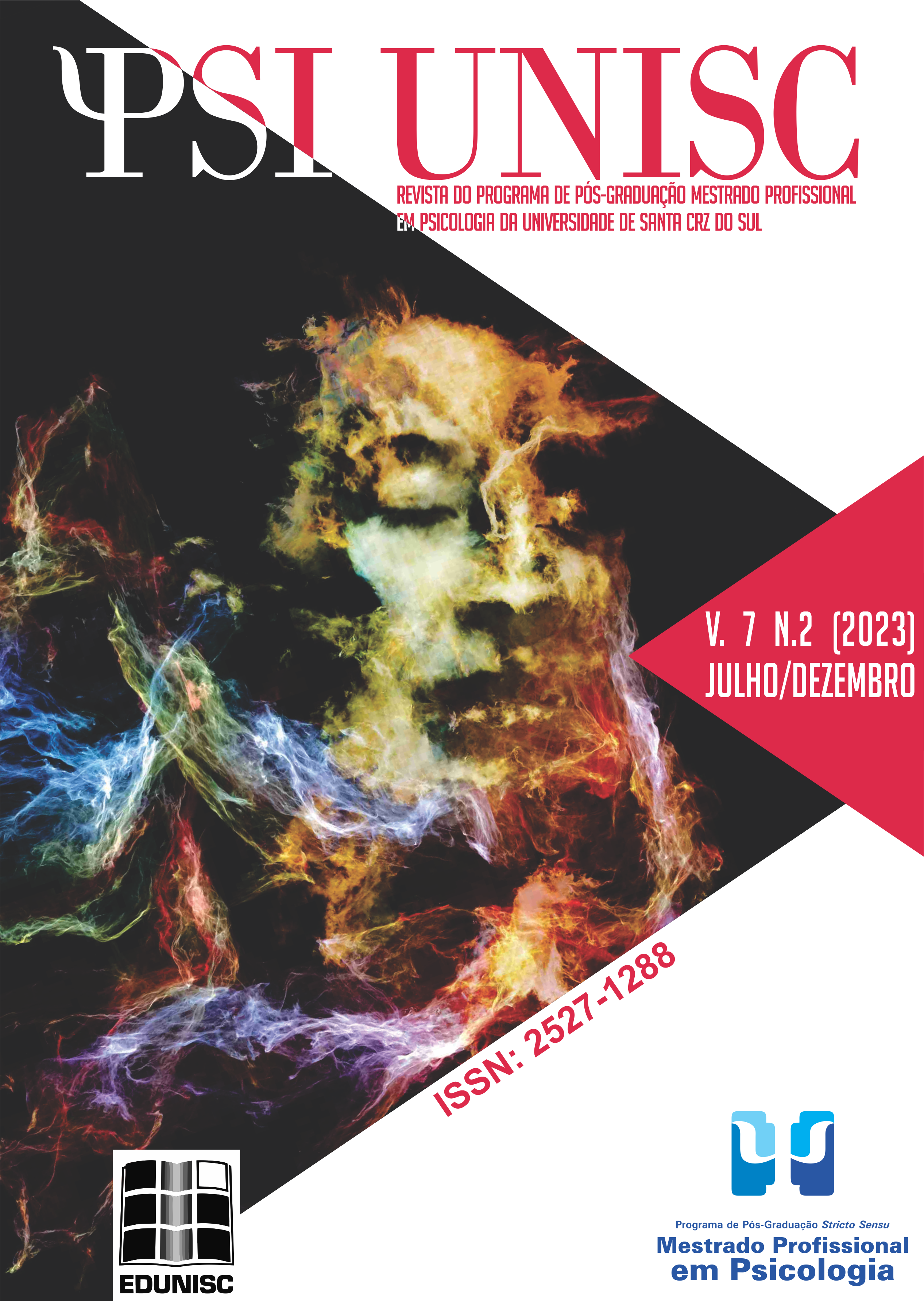The role of the smartphone in the development of the conjugal life cycle
DOI:
https://doi.org/10.17058/psiunisc.v7i2.18396Keywords:
Cyberdependence, Psychology, Marital relationship, SmartphoneAbstract
Information and communication technology has changed the nature of interpersonal relationships. If, on the one hand, the smartphone gains representation in the marital relationship, offering multiple forms of communication, on the other hand, the exclusive attention and excessive use of the cell phone cause distancing from the marital partners. This study aimed to understand the functions of the smartphone in the marital relationship at different stages of the life cycle. This is a qualitative, cross-sectional, descriptive and exploratory research. Participants were 20 heterosexual individuals who constituted 10 cohabiting couples, residing in the State of Rio Grande do Sul, Brazil, who individually answered a sociodemographic questionnaire and a semi-structured online interview. The data were subjected to thematic analysis, which highlighted two themes: 1) The role of the smartphone in the marital life cycle; 2) The pandemic and changes in smartphone use. The results were analyzed using the systemic theory and showed that smartphone use permeates the marital relationship throughout its development and both enhances the adversities of the different stages of the marital life cycle and offers resources for the couple to resolve the difficulties encountered in this path. In addition, the increased use of the device as a result of the Covid-19 pandemic intensifies the complexity of the marital relationship.
Downloads
References
Água, J., Lourenço, M. G., Patrão, I., & Leal, I. (2019). Partner Phubbing (PPhubbing): Validação portuguesa. Psicologia, Saúde & Doenças, 20(1), 234-241. doi: 10.15309/19psd200119
American Psychological Association [APA]. (2019). Diagnostic and Statistical Manual of Mental Disorders (7. ed.). Washington, DC: APA.
Andolfi, M., & Mascellani, A. (2023). Intimidade de casal e tramas familiares. Belo Horizonte: Artesã.
Andrades, B. A., Delatorre, M. Z., & Wagner, A. (2021). Qualidade conjugal: paralelo entre a perspectiva de casais e instrumentos de medida. Revista de Psicología, 39(2), 497-530. doi: 10.18800/psico.202102.001
Bernardi, D., Mello, R., & Féres-Caneiro, T. (2019). Ambivalências frente ao projeto parental: vicissitudes da conjugalidade contemporânea. Revista da SPAGESP, 20(1), 9-23. doi: 10.4013/ctc.2018.112.02
Boechat, I. T., Cabral, H. L. T. B., & Souza, C. H. M. de. (2017). Relacionamentos virtuais e família: Enlaces interculturais. Revista Internacional de Folkcomunicação, 15(35), 141-164. doi: 10.5212/RIF.v.15.i35.0008
Braun, V. & Clarke, V. (2012). Thematic analysis. In H. Cooper, P. M. Camic, D. L. Long, A. T. Panter, D. Rindskopf, & K. J. Sher (Eds.). APA Handbook of Research Methods in Psychology (pp. 5-701). American Psychological Association.
Bröning, S., & Wartberg, L. (2022). Attached to your smartphone? A dyadic perspective on perceived partner phubbing and attachment in long-term couple relationships. Computers in Human Behavior, 126, 1-11. doi: 10.1016/j.chb.2021.106996
Canezin, P. F. M., & Almeida, T. de. (2015). O ciúme e as redes sociais: Uma revisão sistemática. Pensando Famílias, 19(1), 142-155. Recuperado de http://pepsic.bvsalud.org/pdf/penf/v19n1/v1-9n1a12.pdf
Cerveny, C. M. de O., & Berthoud, C. M. E. (2010). Visitando a família ao longo do ciclo vital. São Paulo, SP: Casa do Psicólogo.
Chan, M. (2018). Mobile-mediated multimodal communications, relationship quality and subjective well-being: An analysis of smartphone use from a life course perspective. Computers in Human Behavior, 87, 254–262. doi: 10.1016/j.chb.2018.05.027
Conselho Nacional de Saúde. (2012). Resolução nº 466. Recuperado de http://conselho.saude.gov.br-/resolucoes/2012/reso466.pdf
Conselho Nacional de Saúde. (2016). Resolução nº 510. Recuperado de http://conselho.saude.gov.br-/resolucoes/2016/Reso510.pdf
Conselho Nacional de Saúde. (2021). Orientações para procedimentos em pesquisas com qualquer etapa em ambiente virtual. Recuperado de http://conselho.saude.gov.br/images/Oficio_Circular_-2_24fev2021.pdf
Costa, C. B. da, & Mosmann, C. P. (2015). Relacionamentos conjugais na atualidade: percepções de indivíduos em casamentos de longa duração. Revista da SPAGESP, 16(2), 16-31. Recuperado de http://pepsic.bvsalud.org/pdf/rspagesp/v16n2/v16n2a03.pdf
Dantas, C. R. T., Féres-Caneiro, T., Machado, R. N., & Magalhães, A. S. (2019). Repercussões da Parentalidade na Conjugalidade do Casal Recasado: Revelações das Madrastas. Psicologia: Teoria e Pesquisa, 35, 1-9. doi: 10.1590/0102.3772e3545
Delatorre, M. Z., & Wagner, A. (2021). A relação conjugal na perspectiva dos casais. Ciencias Psicológicas, 15(1), 1-20. doi: h10.22235/cp.v15i1.2355
Delatorre, M. Z., Maesima, G. M.; Coelho, L. R. M, & Wagner, A. (2022). O ciclo de vida de casais brasileiros: Uma revisão integrativa. Psicologia Clínica, 34(1), 191 – 204. Recuperado de http://www.psi.puc-rio.br/site/images/psi_puc/publicacoes/psi3401.pdf
Esteves de Vasconcellos, M. J. (2013). Pensamento sistêmico: o novo paradigma da ciência (10 ed.). Campinas, SP: Editora Papirus.
González-Rivera, J., Segura-Abreu, L., & Urbistondo-Rodríguez, V. (2018). Phubbing en las relaciones románticas: Uso del celular, satisfacción en la pareja, bienestar psicológico y salud mental. Interacciones: Revista de Avances en Psicología, 4(2), 81-91. doi: 10.24016/2018.v4n2.117
Gritti, A., Salvati, T., Russo, K., & Catone, G. (2020). Covid-19 pandemic: A note for psychiatrists and psychologists. Journal of Psychosocial Systems, 4(1), 63-77. doi: 10.23823/jps.v4i1.70
Haack, K. R., & Falcke, D. (2017). Rel@cionamentos.com: Diferenciando os relacionamentos amorosos mediados e não mediados pela Internet. Revista Colombiana de Psicologia, 26(1), 31-44. doi: 10.15446/rcp.v26n1.53241
Hertlein, K. M., & Ancheta, K. (2014). Clinical application of the advantages of technology in couple and family therapy. The American Journal of Family Therapy, 42(4), 313–324. doi: 10.1080/01926187.2013.866511
Instituto Brasileiro de Geografia e Estatística [IBGE]. (2021). Pesquisa Nacional por Amostra à Domicílios Contínua. Recuperado de https://sidra.ibge.gov.br/tabela/7356#resultado
Instituto Brasileiro de Opinião Pública e Estatística [IBOPE]. (2018). Mais da metade dos brasileiros não consegue ficar um dia longe do celular. Recuperado de https://tecnologia.ig.com.br/2019-02-22/brasileiros-nao-ficam-sem-celular.html
Leggett, C., & Rossouw, P. J. (2014). The impact of technology use on couple relationships: A neuropsychological perspective. International Journal of Neuropsychotherapy, 2(1), 44-99. Recuperado de https://www.thescienceofpsychotherapy.com/the-impact-of-technology-use-on-couple-relationships/
Li, X. (2021). Mobile-Mediated Communication in Romantic Relationships: The Effects of Communication Indicators and Love Attitude on Relationship Quality. Cyberpsychology, Behavior and Social Networking, 24(7), 480-487. doi: 10.1089/cyber.2020.0675
Ligman, K., Rodriguez, L. M., & Rocek, G. (2021). Jealousy and electronic intrusion mediated by relationship uncertainty in married and cohabiting couples during COVID-19. Cyberpsychology, Behavior, and Social Networking, 24(7), 444-449. doi: 10.1089/cyber.2020.0669
Maziero, M. B., & Antunes de Oliveira, L. (2017). Nomofobia: uma revisão bibliográfica. Unoesc & Ciência - ACBS, 8(1), 73–80. Recuperado de https://periodicos.unoesc.edu.br/acbs/article/view/11980
McDaniel, B. T., & Coyne, S. M. (2016). “Technoference”: The interference of technology in couple relationships and implications for women’s personal and relational well-being. Psychology of Popular Media Culture, 5(1), 85–98. doi: 10.1037/ppm0000065
McDaniel, B. T., & Radeski, J. S. (2018). Technoference: Parent Distraction With Technology and Associations With Child Behavior Problems. Child Development, 89(1), 100-109. doi: 10.1111/cdev.12822
McDaniel, B. T., Galovan, A. M. & Drouin, M. (2020). Daily technoference, technology use during couple leisure time, and relationship quality. Media Psychology, 24(5), 637-665. doi: 10.1080/15213269.2020.1783561
McGoldrick, M., & Shibusawa, T. (2016). O ciclo vital familiar. In F. Walsh (Org.), Processos normativos na família (pp. 375-398). Artmed. doi: 10.1037/ppm0000065
Mendes-Campos, C., Féres-Carneiro, T., & Magalhães, A. S. (2020). Extimidade virtual e conjugalidade: Possíveis repercussões. Psicologia: teoria e prática, 22(1), 285-299. doi: 10.5935/1980-6906/psicologia.v22n1p285-299
Minayo, M. C. de S. (2017). Amostragem e saturação em pesquisa qualitativa: Consensos e controvérsias. Revista Pesquisa Qualitativa, 5(7), 01-12. Recuperado de https://editora.sepq.org.br/rpq/article/view/82
Minuchin, S. (1984). Familias y terapia familiar. Buenos Aires: Gedisa.
Neumann, D. M. C., & Missel, R. J. (2019). A Influência da Tecnologia nas Relações Entre Pais e Filhos Adolescentes. Pensando Famílias, 23(2), 75-91. Recuperado de http://pepsic.bvsalud.org/pdf/penf/v23n2/v23n2a07.pdf
Nichols, M. P. & Schwartz, R. C. (2007). Terapia familiar: conceitos e métodos. Porto Alegre, Artes Médicas.
Nina-Estrella, R., Montero-López Lena, M. & Manríquez Betanzos, J. C. (2020). Phubbing, comunicación tecnológica y calidad de la relación de pareja. Revista Iberoamericana de Psicología, 13(3), 38-48. Recuperado de https://reviberopsicologia.ibero.edu.co/article/view/1906
Oliveira, G. L., & Ribeiro, A. P. (2021). Relações de trabalho e a saúde do trabalhador durante e após a pandemia de COVID-19. Cadernos de Saúde Pública, 37(3). doi: 10.1590/0102-311X00018321
Oliveira, T. S., Rocha Neto, M. P., Barreto, L. K. S., Brito, L. M. P., & Pinheiro, L. V. S. (2020). 'Tenho Celular, Logo Existo' - Um Estudo da Nomofobia na Formação de Futuros Gestores. Revista de Administração da Unimep, 18(1), 91-110. Recuperado de http://www.spell.org.br/documentos/ver/57936/-tenho-celular--logo-existo----um-estudo-da-nomofobia-na-formacao-de-futuros-gestores/i/pt-br
Oliveira, R. S., Barros, B. M. C, & Goulart, G. M. (2016). As tecnologias da informação e comunicação na (des)construção das relações humanas contemporâneas: implicações do uso do aplicativo Tinder. Revista Brasileira de Direito, 12(1), 88-99. doi: https://doi.org/10.18256/2238-0604/revistadedireito.v12n1p88-99
Porreca, W. (2019). Relação conjugal: Desafios e possibilidades do “nós.” Psicologia: Teoria e Pesquisa, 35(número especial), 1-12. doi: 10.1590/0102.3772e35nspe7
Primo, A. (2020) Afetividade e relacionamentos em tempos de isolamento social: intensificação do uso de mídias sociais para interação durante a pandemia de COVID-19. Revista Comunicação & Inovação, 21(47), 176-196. Recuperado de
https://seer.uscs.edu.br/index.php/revista_comunicacao_inovacao/article/view/7283/3187
Roberts, J. A., & David, M. E. (2016). My life has become a major distraction from my cell phone: Partner phubbing and relationship satisfaction among romantic partners. Computers in Human Behavior. 54(1), 134-141. doi: 10.1016/j.chb.2015.07.058
Scheeren, P., Neumann, A. P., Gryzbowsky, L. S., & Wagner, A. (2015). Como se caracterizam os conflitos conjugais? In: A. Wagner, C. Mosmann, D. Falcke. Viver a dois: Oportunidades e desafios da conjugalidade (pp. 41-65). São Leopoldo, RS: Editora Sinodal.
Schulz, C., & Colossi, P. (2020). A Transmissão Transgeracional dos Modelos Conjugais. Pensando Famílias, 24(1), 45-66. http://pepsic.bvsalud.org/scielo.php?script=sci_arttext&pid=S1679-494X2020000100005
Tissot, D. W., & Falcke, D. (2017). A conjugalidade nas diferentes etapas do ciclo vital familiar. Quaderns de Psicologia, 19(3), 265-276. doi: 10.5565/rev/qpsicologia.1399
Vinuto, J. (2014). A amostragem em bola de neve na pesquisa qualitativa: Um debate em aberto. Temáticas, 22(44), 203-220. doi: 10.20396/tematicas.v22i44.10977
Wagner, A., Mosmann, C. P., Scheeren, P., & Levandowski, D. C. (2019). Marriage and Conflict Resolution. Paidéia, 29, 1-9. doi: 10.1590/1982-4327e2919
Wagner, A., & Delatorre, M. Z. (2018). A conjugalidade e suas transformações nos diferentes estágios do ciclo vital. In M. A. dos Santos; D. Bartholomeu; J. M. Montiel (Eds.), Relações interpessoais no ciclo vital: Conceitos e contextos (pp. 271-284). Brasília, DF: Vetor.
Wang, X., Zhao, F., & Lei, L. (2021). Partner phubbing and relationship satisfaction: Self-esteem and marital status as moderators. Current Psychology, 40, 3365–3375. doi: 10.1007/s12144-019-00275-0
Yang, H., Liu, B., &Fang, J. (2021). Stress and Problematic Smartphone Use: Smartphone Frequency and fear of Missing Out as Mediators. Frontiers in Psychiatry, 12, 1-8. doi: 10.3389/fpsyt.2021.659288
Yin, R. K. (2016). Compreendendo a pesquisa qualitativa. In R. K. Yin (Ed.), Pesquisa qualitativa do início ao fim (pp. 3-18). Porto Alegre, RS: Editora Penso.
Downloads
Published
How to Cite
Issue
Section
License
The submission of originals to this journal implies the transfer, by the authors, of the printed and digital publication rights. The copyrights for the published articles are those of the author, with periodical rights on the first publication. Authors may only use the same results in other publications clearly indicating this journal as the medium of the original publication. Because we are an open access journal, we allow free use of articles in educational and scientific applications provided the source is cited under the Creative Commons CC-BY license.




